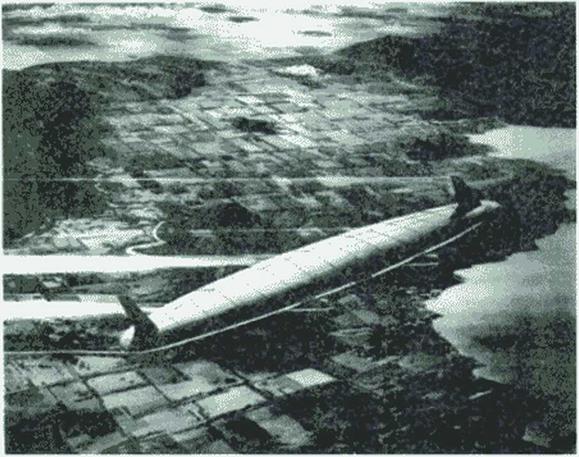Stanford Studies
As hU Ph D. thesis at Stanford. Van dcr Velden undertook the development of a general evaluation tool for preliminary design of commercial supersonic aircraft, including the OFW (423)- |42SJ. This resulted in the preliminary design of an OFW that provided additional impetus and guidance to the NASA Systems Analysts Branch in their own studies of such aircraft.
Morris, in his Stanford Pti D. thesis, examined the integrated aerodynamic/control system needed for a rigid oblique wing aircraft (OWA). that is. an oblique wing with fuselage (426). He showed that by tilting the pivot axis, adverse coupling could be reduced and handling qualities improved. He subsequently extended these studies to the integrated aerodynamic and control system design of an oblique flying wing. The configuration matched that of a NASA design for a 400 passenger OFW |427|. Moms noted the utility of designing the control law for the principal axes. He then demonstrated this control law with two radio-controlled OFWs. The first was ten feel in span and flew successfully at up to 65 degrees sweep. The second was a twenty foot span OFW powered by two pivoting. 5 horsepower, ducted fan engines. Ten 25% chord trailing edge flaps were controlled by a Motorola 68020 CPU and a 68881 math coprocessor. The aircraft was designed to be able to fly at sweep angles from 35 to 65 degrees. Flight sensors were a З-axis rate gyro, a 2-axis wind sane and an airspeed indicator.
|
Figure 143 Л NASA vtbt’i concept of an OFW. |
In addition to the ten trailing edge control surfaces, two Hying vertical fins, two throttles and four landing gear stmts were driven by commercially available actuators. Actuator bandwidth limited the static stability margin to -1.8*$. This aircraft Hew in May 1994. successfully completing a four minute flight circling the field twice, changing its sweep from 35 to 50 degrees and back It circled the field by turning toward the trailing tip. which resulted in sweep angles as low as 20 degrees because of the high damping in yaw. Morris, his model aircraft, and some of his results are depicted in some Figures of Chapter 19.














